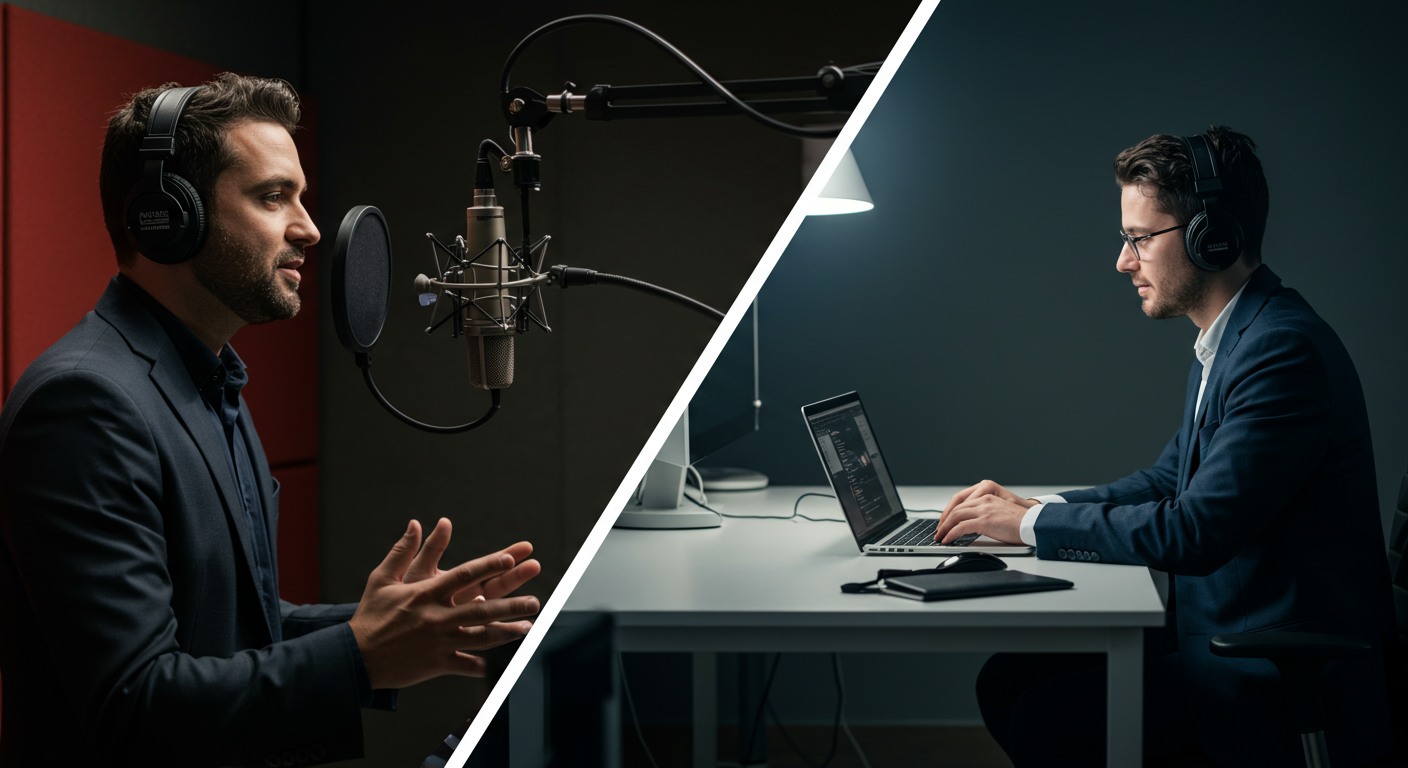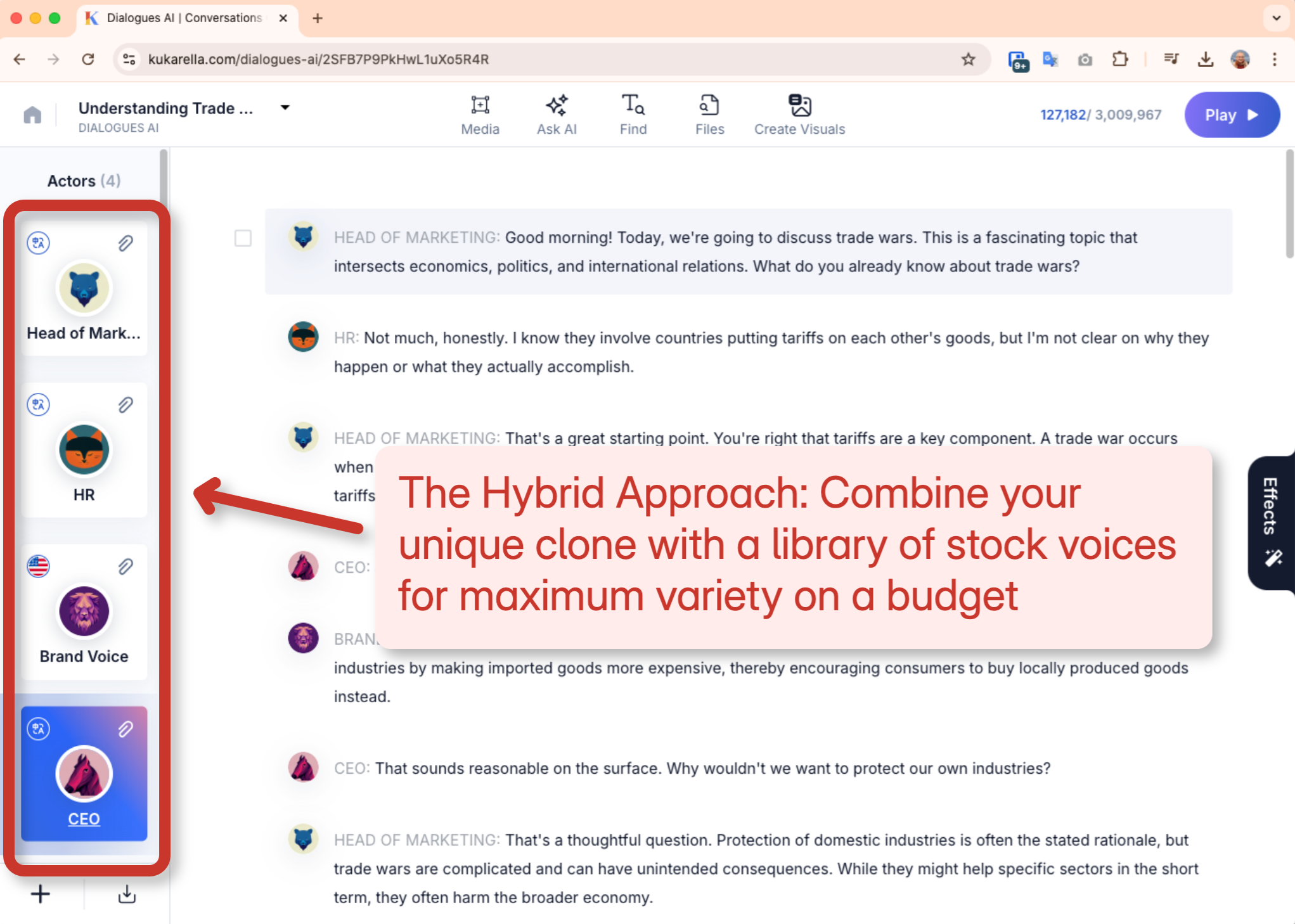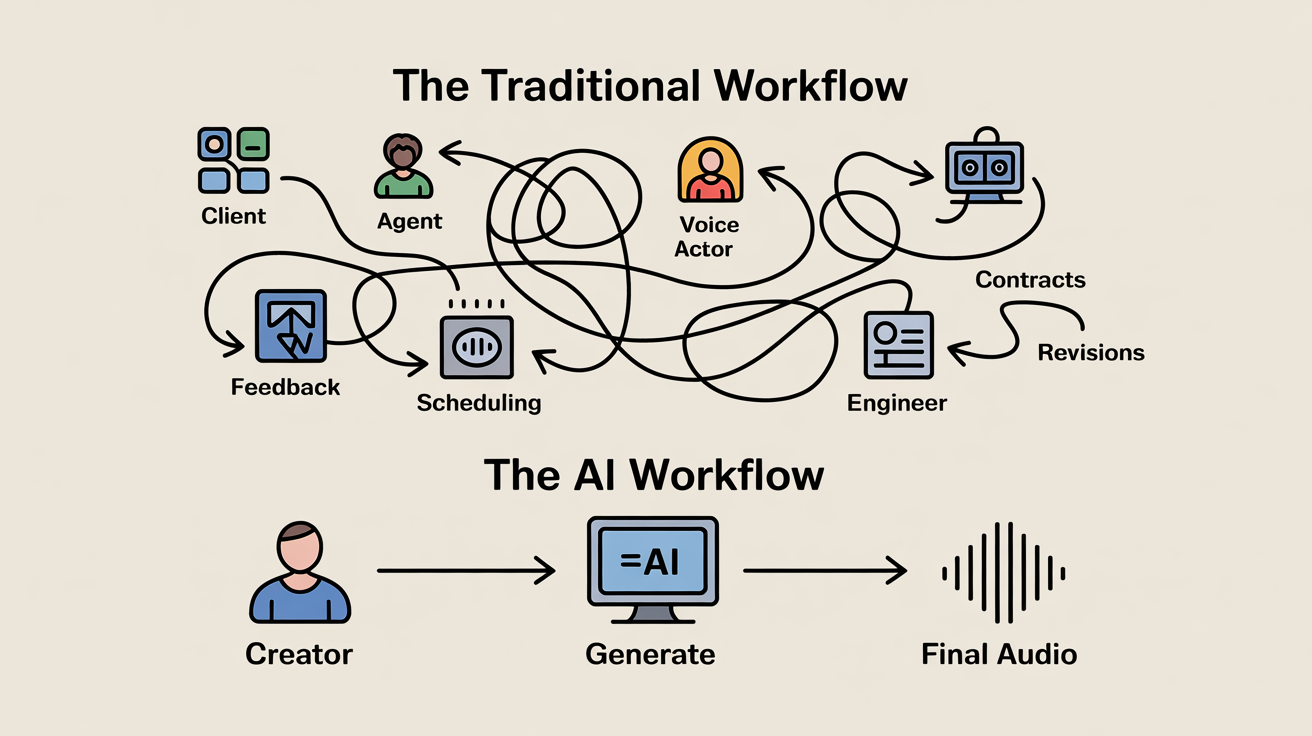A startup founder is three days from launching their flagship product. The explainer video is shot, edited, and perfect—except for the voiceover. Their budget is tight. They can hire a professional voice actor on a platform like Voices.com, which will cost them $500 and take 48-72 hours if all goes well. Or, they can use their AI voice cloning subscription and have a finished audio track in the next 15 minutes. The AI voice is 95% as good as the pro. Is that 5% difference in emotional nuance worth a two-day delay and half of their remaining marketing budget?
This is no longer a hypothetical. It is a real-world decision that millions of creators, marketers, and business owners face every single day. The crossroads between human artistry and artificial efficiency has arrived, and choosing the right path has significant consequences for your project's budget, timeline, and perceived quality.
The debate is often framed as a battle: Man vs. Machine. But this is a flawed premise. The smart creator knows it's not a war; it's about choosing the right tool for the job. You wouldn't use a sledgehammer to perform surgery, nor a scalpel to demolish a wall.
 voice recording vs text to speech software
voice recording vs text to speech softwareThis report is a data-driven, brutally honest analysis of when to hire a professional voice actor and when to deploy an AI voice clone. We will move beyond opinion and into a tangible breakdown of cost, time, emotional performance, and scalability, empowering you to make the right call for your next project.
The Contenders: The Artisan vs. The Digital Twin
1. The Traditional Voice Actor (The Artisan)
A human voice actor is a trained performer. They are not just reading words; they are interpreting them. They bring life experience, emotional intelligence, and the ability to take direction to create a performance that is truly unique. They are masters of nuance, able to convey sarcasm, subtext, and vulnerability in ways that algorithms are still learning to replicate.
Best For: Projects where emotional connection and unique character performance are the absolute highest priorities.
2. The AI Voice Clone (The Digital Twin)
An AI voice clone is a perfectly consistent, infinitely scalable digital replica of a voice. It is a tireless workhorse that can generate hours of audio without fatigue, maintain perfect consistency across months of production, and perform revisions in seconds. It offers unparalleled speed and cost-efficiency.
Best For: Projects where consistency, scalability, speed, and budget are the driving factors.
The Five-Factor Analysis: A Head-to-Head Breakdown
Let's break down the decision into the five key factors that should drive your choice.
| Factor | Traditional Voice Actor | AI Voice Clone | Verdict |
| 1. Cost | High. Rates range from 200 − 200− 500 for short projects (e.g., 1-2 min video) to 200 − 200− 400 per finished hour for audiobooks. Union (SAG-AFTRA) projects have higher, standardized rates. | Extremely Low. Typically a monthly subscription ( 15 − 15− 50) or a credit-based system. An entire audiobook could be generated for the cost of one hour of studio time. | Winner: AI Voice Clone (by a landslide) |
| 2. Speed & Time | Slow. Casting can take days. Recording must be scheduled. Revisions require new sessions. A typical project turnaround is 2-5 business days. | Instantaneous. Audio is generated in minutes. Revisions are completed in seconds by editing text. | Winner: AI Voice Clone |
| 3. Emotional Nuance | Superb. A skilled actor can interpret a script, create a unique character, and convey complex emotions like irony, humor, and pathos. They are a creative partner. | Improving, but Limited. Can deliver pre-set emotions (Happy, Sad, Angry) but struggles with subtext and complex nuance. It executes instructions; it does not interpret art. | Winner: Traditional Voice Actor |
| 4. Consistency | A Constant Challenge. A narrator's voice changes with time of day, health, and energy levels. Matching a "punch-in" recording months later is extremely difficult. | Mathematically Perfect. The AI voice will sound exactly the same on the last word of a 60-hour audiobook as it did on the first. Perfect consistency is its superpower. | Winner: AI Voice Clone |
| 5. Revisions | Costly and Slow. Requires a new booking, new studio fees, and new engineering time. A simple sentence change can cost hundreds of dollars and days of delay. | Free and Instant. A typo or a script change is fixed by editing the text and clicking "generate" again. The cost is zero. The delay is minutes. | Winner: AI Voice Clone |
The Scenario Matrix: Choosing the Right Tool for the Job
Let's apply this analysis to four common projects.
Scenario 1: The 30-Second Super Bowl Ad
You need a voice that is witty, memorable, and drips with a specific, ironic charisma.
- Analysis: The project's success hinges 100% on a unique, high-impact emotional performance. The cost is secondary to the creative result.
- Verdict: Hire a Traditional Voice Actor. This is a job for an artist who can partner with your creative director to craft the perfect 30-second performance. The AI's lack of true subtext understanding would be a liability.
Scenario 2: The 2-Hour Corporate Compliance Course
You need to narrate 150 slides of dense, technical information for an internal training module. The key requirements are clarity and consistency.
- Analysis: Emotional performance is not a factor. The primary need is for a clear, professional, and perfectly consistent voice that doesn't vary from Module 1 to Module 10. The budget is an internal department cost.
- Verdict: Use an AI Voice Clone. This is the perfect use case. It will be thousands of dollars cheaper, infinitely faster, and will provide a level of consistency a human narrator would struggle to match over hours of dry material.
Scenario 3: An Ongoing "Top 10 Facts" YouTube Channel
You need to produce two 10-minute videos per week with a consistent, recognizable host voice.
- Analysis: The key here is scalability and speed. The narration is straightforward. Hiring a voice actor twice a week would be a logistical and financial bottleneck, killing the channel's viability.
- Verdict: Use an AI Voice Clone. The creator can clone their own voice, ensuring a consistent brand identity. This allows them to focus on research and editing, generating the audio for each video in minutes.
Scenario 4: An Indie Video Game with 500 Lines of NPC Dialogue
You're a small game studio on a tight budget. You need voices for 15 different non-player characters (NPCs).
- Analysis: Hiring 15 different voice actors is not financially feasible. Having one actor voice all 15 roles can sound repetitive.
- Verdict: Hybrid Approach. Use an AI platform like Kukarella that allows you to create multiple character voices. You can use your own cloned voice, apply different emotional styles and pitch/speed settings for each character, and mix in some high-quality stock TTS voices for variety. This provides vocal diversity while staying within a shoestring budget.
 Screenshot of Kukarella showing a hybrid project with a cloned narrator voice and multiple different stock AI voices for other characters
Screenshot of Kukarella showing a hybrid project with a cloned narrator voice and multiple different stock AI voices for other charactersFROM THE TRENCHES
"AI voice isn't a replacement for me, it's a tool. I use my own voice clone for two things: auditioning and revisions. I can submit an audition for a huge script in 10 minutes instead of spending an hour in the booth. And when a client needs a one-sentence fix, my AI 'punch-in' saves them hundreds of dollars. It allows me to focus on the high-value, high-performance jobs."
— Cissy Jones, BAFTA-winning voice actor (Firewatch, Baldur's Gate 3), speaking on the "AI in Audio" podcast.
"Plot Twist" Moment: The Real Cost of a Human Actor Is Not Their Fee
When you budget for a voice actor, you calculate their fee, the agent's cut, and the studio time. But you're missing the biggest cost: The Hidden Cost of Friction.
 Flowchart comparing the complex, multi-stakeholder traditional voiceover workflow to the simple, linear AI voiceover workflow
Flowchart comparing the complex, multi-stakeholder traditional voiceover workflow to the simple, linear AI voiceover workflowThe traditional process is loaded with logistical and cognitive friction:
- Casting Friction: Writing a casting call, sifting through dozens of auditions.
- Scheduling Friction: Aligning the schedules of the actor, the director, the engineer, and the studio.
- Creative Friction: The back-and-forth of directing, giving feedback, and managing multiple takes.
- Revision Friction: The entire process starts over for even the smallest change.
The Twist:
The true value of AI voice cloning isn't just that it saves money; it's that it eliminates nearly all process friction. It transforms voiceover from a multi-day, multi-stakeholder logistical operation into a simple, one-person task that takes minutes. This frees up enormous amounts of time and mental energy that can be reinvested in the creative aspects of the project.
The Decision Flowchart: A Visual Guide
Frequently Asked Questions (FAQ)
Q: Can I use an AI voice for a union (SAG-AFTRA) project?
A: This is a complex and evolving issue. SAG-AFTRA has negotiated agreements with major studios that allow for the use of AI under specific, consent-based conditions with fair compensation. Using AI to replace a union actor on a union project without following these specific contracts is a major violation.
Q: What if I need a very specific voice, like "a 1940s radio announcer" or "a wise old wizard"?
A: Here, the human actor initially has the edge. However, AI is catching up. On platforms like Kukarella, you can use text prompts to generate new TTS voices (e.g., "Create a voice that sounds like a classic film noir detective"), offering a powerful middle ground.
Q: Will the audience be able to tell it's an AI?
A: For high-quality clones used for narration, the average listener will likely not notice or care. However, for highly emotional or character-driven content, discerning listeners may feel a lack of depth compared to a professional actor. The question is not "can they tell?" but "does it matter for this specific context?"
The choice is no longer binary. It's strategic. By understanding the distinct strengths and weaknesses of both human artisans and digital twins, you can move beyond the hype and make the smartest possible decision for your story, your schedule, and your bottom line.